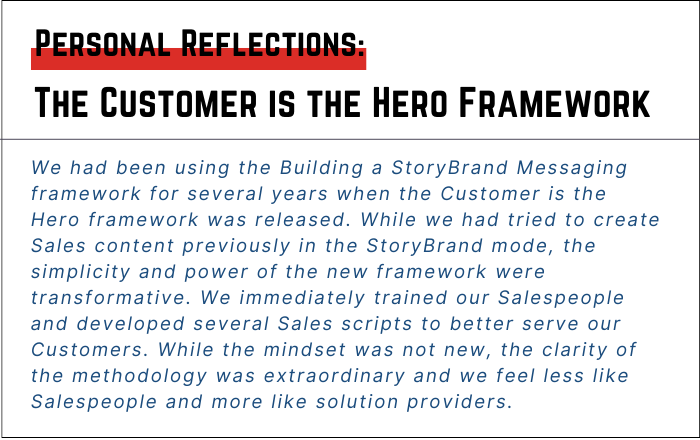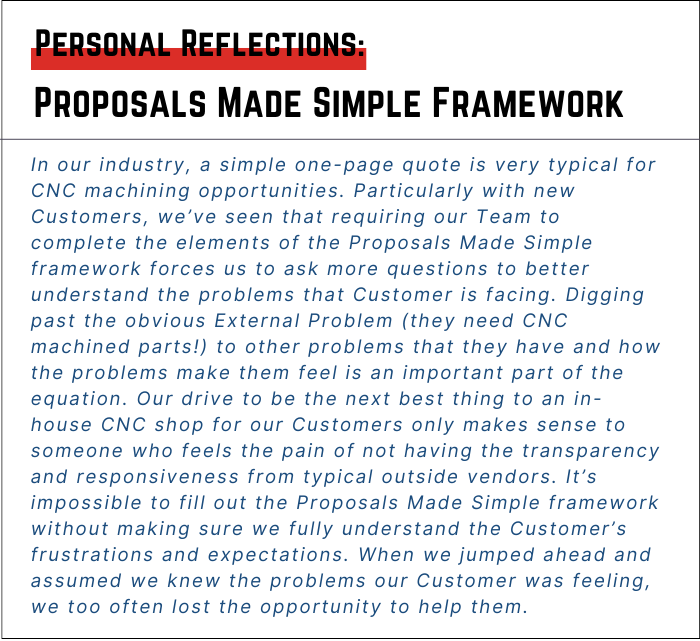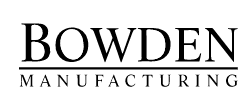Introduction
Do you understand how to use the power of story to close sales in your business?
In this Series, we’re reviewing the 6-Step Plan to run your business from Donald Miller’s latest book, How to Grow Your Small Business, and the online platform at businessmadesimple.com. The analogy of an airplane helps describe the 6 Steps and this week, we’re continuing with Step 3, the Left Engine, your Sales.
Sales in a small business are often the least desirable aspect of owning a business as so few people like to sell. In this blog, we’ll review the principles for the Left Engine (Your Sales) in detail so you can employ the Customer is a Hero framework, including the Online Sales Script, and the Proposals Made Simple framework to properly invite Customers into a compelling story that will drive sales through your improved clarity and concise language. You’ll get the confidence and the words to use so the power of story can provide the Sales “thrust” for your small business airplane so it can take flight.
Step 3 – The Left Engine (Your Sales) – 2 Frameworks & 1 Tool to Create Thrust to Drive Your Business Airplane
The Customer is the Hero Framework
One of the least trusted groups of people on the planet is Salespeople. A recent HubSpot survey showed that the only group less trusted was Congress! Very few people want to sell and nobody wants to be pushy or sleazy.
Unfortunately, it’s really important that you are able to sell in order to grow your business and your career. The Customer is the Hero framework is designed to be a Sales framework for people who hate selling. It’s designed to make you feel so comfortable that you don’t even need to think about selling because you’ll get used to framing conversations in a manner that uses the power of story to invite Customers into a story where they are the Hero and you are the Guide. You’ll engage in Sales conversations that feel natural and kind. As you get accustomed to determining the problem they are facing through conversation, you’ll position yourself as a helpful Guide in their life. As you comfortably engage with them, you’ll earn their respect and admiration, closing more sales without feeling like you sold anything.
The overview of the framework involves 5 steps:
1. Start with your Customer’s problem.
As a Salesperson, it can be easy to assume that all Customers have the same problem. Unfortunately, that’s rarely true, and acting if you know their problem doesn’t make them feel heard. The reason they have potential interest in your product is because of their particular problem and if you can learn about the problem and how it makes them feel, you’ll know whether you can help them solve it. Talking about the problem is the hook that gets them interested in the conversation, so as you articulate the problem back to them you’ll be inviting them into a story about buying your product and solving that problem.
2. Position your product as the solution to their problem.
In starting with the problem, you’ve invited the Customer into a story, but if you want to sell more of your product, you need to position your product as the solution to that problem. Once you’ve positioned your product as a solution to the Customer’s problem, the perceived value of the product greatly increases. As you talk with a Customer, you’ll start listening for a connection between the problem and the aspect of your product that solves their problem. Only sell to people who have a problem that your product solves and those that will appreciate having been sold the solution. Don’t list features of your product that your Customer isn’t thinking about. You may be proud of those features, but if they aren’t related to the problem the Customer is worried about, you risk complicating or confusing your Customer unnecessarily. When they see your product as the solution to their problem, they will ask you if they can buy it, and you won’t have to sell anything.
3. Build a bridge from their problem to your solution by giving them a 3-step plan.
At this point, the Customer is ready to make a purchase but it’s likely they are both afraid and confused, even if they don’t want to admit it. Make it easy for them to take the journey from their problems to your solution with a 3-step plan. Laying out the general steps they’ll need to take will ease their mind about the process and remove the fear and confusion. Customers will follow steps that are simple and easy to understand, so keep the number of steps to just three, even if you need to combine some of them.
4. Create a sense of urgency by painting the stakes.
Stories get interesting when there is something at stake. Being able to discuss with your Customer both the positive and negative stakes will help them see what they have to win or lose based on the decision they’ll make regarding your product. The more clearly you can describe the negative consequences they might experience if they don’t do business with you, and the positive consequences of using your product, the more urgency they’ll feel in their decision.
5. Invite your Customer to place an order.
If your Customer is struggling with the problem you solve and can afford the solution, they will respect you when you ask for the sale. If you don’t ask, they will feel as though you don’t believe in your product. Establish an appropriate call to action that you can say to ask for the sale so it will feel natural. Don’t be vague or passive. If you make it simple and direct, you’ll give the Customer an opportunity to accept or reject your offer, rather than waiting for an indeterminate future decision time.
The Follow Up Note
Using the Customer is the Hero framework allows you to engage your Customer in a positive way that will lead to more sales. After buying, the Customer may still have two questions:
- “Did I make the right decision?”
- “Have I been used?”
With those nagging questions in the back of their mind, you can ease their minds with a follow-up note affirming they made the right decision and that the relational exchange between the two of you was genuine and based on mutual respect. By following back up with the Customer in this way, it will make them feel better about their purchase, it will close the story loop in their minds, and it will lead to more business from them and others they refer to you. Make sure your note contains three points:
1. “Thank you for your order.”
It’s a sign of respect and appreciation based on the transaction they just make with you.
2. A personal compliment.
Make an observation, tailored specifically to them, about some aspect related to how or why they made the decision to buy your product. It could be something you saw that you admire or respect that you learned during the interaction.
3. “If I can help you in any other way, please let me know.”
A genuine offer to be helpful to them in the future helps make them feel good about the business relationship you’ve established.
By following up with a note in this way, you’ll affirm your Customer and remove any lingering tension following the transaction. They’ll be excited that you’ve acted as their Guide to help solve their problem and draw a successful conclusion.
You’ll be amazed to discover how using the Customer is the Hero Framework will simplify the way you talk to Customers and you’ll soon build the positive habit in your conversations of uncovering their problems and looking for ones that your product can solve for them.
You’ll feel good about only engaging when your product can be the solution to their problem and you know you’re being helpful to them. You’ll be able to comfortably and conversationally invite Customers into an engaging story with you positioned as the Guide to help them achieve success.

OnlineSalesScript.Com Tool
The Online Sales Script tool is an online resource that will help you organize your Sales communications so that they follow the correct sequence to engage Customers. Each of the 5 steps of the Customer is the Hero framework is color-coded for visibility so you can see each step clearly, making sure nothing is left out.
Delegate with Confidence Blog Series – Online Sales Script Example
As a Leader, it can be frustrating to attempt to delegate because it takes longer than just doing it yourself and too often you get sucked back into doing the task anyway.
Good delegation is not an accident. In this Blog Series, we will outline the DR GRAC Delegation Framework, a proven tool to ensure that you can delegate effectively to your Team without the worry and frustration you've experienced in the past.
We'll help you: 1. Identify an opportunity that delegation can put the work in the proper hands on your Team. 2. Work the DR GRAC delegation framework to effectively delegate the task. 3. Follow the Accountability Plan so you and the Task Owner feel great about the outcome.
Trying to do everything yourself is not an effective way to lead your Team. Without a consistent framework for effectively delegating tasks, your results will be mixed and frustration will be high for both you and your Team. Failing to delegate can leave you stressed out and only able to work IN your business and not ON your business. It's easy to believe you're the only person that can do what you do but can feel like you've got the whole world on your shoulders. Trying to do it all limits your growth and can negatively impact your ability to show up for your Team and even your family.
Using the DR GRAC Delegation Framework will allow you and your Team to get dramatically more done every day. You won't have to do everything by yourself and you won't live in constant worry that your Team will mess everything up. The clarity you develop through your delegation and the Accountability Plan will empower your Team to find creative solutions to problems within clearly defined guidelines. You will stay aware of results through the planned accountability checks. Your time will begin to free up for higher-level work, growing your business and providing the ability to scale beyond just what you can do yourself.
Join us on this 7-part Blog Series as we work through the DR GRAC Delegation Framework in detail. Complete the exercises and practice your new skills as you delegate more effectively. Each week we'll outline the next step, guiding you through setting up your delegation, creating your Accountability Plan, and enjoying the freedom that comes with empowering your Team.
You’ll be amazed how transformative it can be for your Sales Team when you complete an Online Sales Script together using the OnlineSalesScript.com tool. Your Sales messaging will be clear and concise as you and your Sales Team consistently and conversationally invite your Customers into an engaging story where you help them to solve their Problem through your product. You’ll earn their respect and admiration, closing more sales without feeling like you sold anything.
Proposals Made Simple Framework
In many industries, formal proposals are the norm and anything less is unacceptable. As a small business owner, you may not think you need to send proposals as it’s not typically done in your industry. Unfortunately, that belief is costing you business. A great proposal can be your secret weapon to closing more sales.
Depending on the nature of your product, you may or may not be able to talk to all the decision-makers at the same time and get them to make a timely decision while you’re with them. That means that whoever you talked with will now be the person trying to “sell” your product to the rest of their decision-making group. A properly formatted proposal ensures that your message will be properly conveyed, even if you’re not in the room when the final decision is being made.
The Proposals Made Simple framework contains the following components:

While there is a lot that goes into a Proposal, you can build templates for many of the typical problems that you solve for Customers to help streamline the process. By personalizing the Proposal, the Customer will know that you were listening to them and that you understand their situation. The Proposal may feel a bit more formal than is typical for your industry, it will convey your message more completely and show your professionalism and help the Customer want to do business with you.

You’ll be amazed how transformative it can be to provide a Proposal to your Customers as a part of your Sales process. Your ability to clearly describe everything you’ve discussed as it relates to their problem and your solution will give you a significant edge over your competition. You’ll close more sales and grow your business.
Final Thoughts
The third step from Donald Miller’s book, How to Grow Your Small Business, is the Left Engine – Your Sales. You’ll employ the Customer is a Hero framework to invite Customers into an engaging story where you are positioned as the Guide. You’ll use the Online Sales Script to clearly see the different elements of your wording so that all of the sections are included in the proper order. The Proposals Made Simple framework can be a secret weapon to provide a written synopsis of the story so others in the Customer organization will understand why your solution to the problem makes sense for them.


